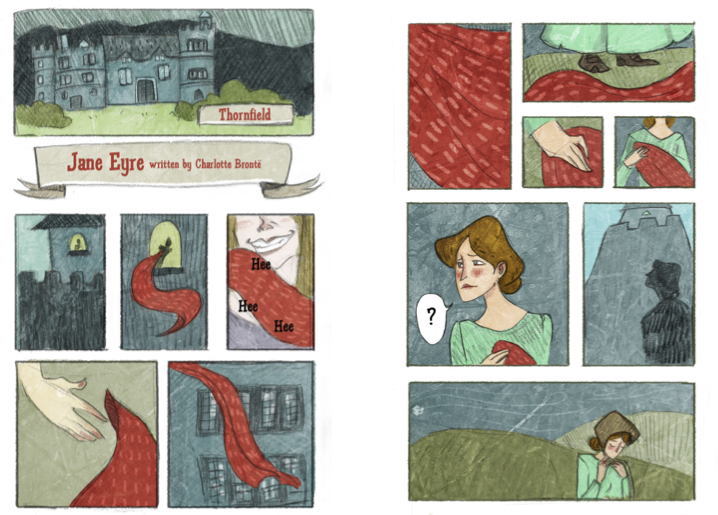Chrisanne Hernandez and Professor Robert Barrett, Department of Visual Arts
The purpose of this project was two fold. First, we wanted to create a literacy tool that could be used by educators to help bridge the gap between picture books and novels. Second, we wanted to expand our skills and knowledge through the art form of sequential storytelling. It was interesting because as we began this journey our desire to help others was the main goal. But over the year, I’ve found that I, myself, will be one of the largest beneficiaries of this project.
Even though I began this project with plenty of research done, I was amazed to see how much more research was still needed. In a group of 12 illustration students, none of us knew exactly how to go about creating a graphic novel, let alone a graphic novel adaptation of lengthy classical literature pieces. I was fortunate enough to find guidance through Jake Parker, an industry professional. Because of the Orca Grant I was able to pay for a class he taught specifically for those interested in creating graphic novels. Through this class I was able to understand better the creative process of crafting a graphic novel. I learned valuable lessons about page flow, color scheme, dialogue and many more techniques that help a graphic novel come together. It was during this class that I was also able to design my characters and decide upon the color schemes I wanted to use, and what I wanted them to portray. Because of the guidance provided by Jake Parker, and my professor, Robert Barrett, I was able to create clean and readable characters and environments. Examples of my work are pictured below.
The greatest struggle I believe that most of us faced was how long it actually took to create a single spread (two comic pages). We all labored intensively on the preproduction aspect of this project with the desire to create the perfect characters and page layouts. I learned, however, that the “design as you go” technique is best suited for the type of work we created. Since I had never created a graphic novel, the idea of “designing as you go” seemed impossible to me. To begin creating pages without any solid designs seemed out of the question. Yet, had I followed this advice I would have discovered just how much those original designs changed when I began putting together the actual pages. Because sequential art was so foreign to me at the beginning of this project, I did not trust my original instinct. Because of this experience, I now have the confidence to create graphic novels in my future career.
This project is not yet complete – we each have pages of our stories we need to finish. We are hoping to complete them by the end of April 2013. However, we were able to put together a show, displaying the work that has thus far been completed. The show is entitled “Restoring the Love of Reading” and is on display in the Harold B. Lee Library through early January. This was a great experience and something that we were able to do because of funds provided through the ORCA Grant. Together as a group we were able to discuss and decide the method we would use to hang our show, what materials we should use, what should be displayed and when we should display it. Although I was not the leader of the group, I still learned valuable lessons in meeting show deadlines and working with gallery curators. Because this project was a collaborative effort, we all were responsible for each other’s success. Critiquing each other became a very helpful practice – one that I know I will carry over and value when I enter the professional field. Urging others and being urged by others to meet deadlines was also an experience one might feel in a professional studio. Being able to replicate these types of environments as a student has been helpful in allowing us to see what we might expect in our future careers.
For the show, we held a very successful opening reception and I personally invited several families with young children and I hoped to gage their reactions. It was exciting to hear which pieces and stories were the children’s favorites, and also to get positive feedback from the parents. From what I gathered, many thought our project was worthwhile. Children who struggle to read may have difficulty advancing beyond picture books to novels. The use of graphic novels is a way to help ease these children into more difficult reading because they use pictures to tell a story and there is room for more advanced and thought provoking plotlines – something which is not possible with picture or short chapter books.
I am very grateful for the opportunity that the ORCA Grant provided me to participate in this project. It has reconfirmed in me the important role that graphic novels can play in promoting literacy for children. I hope to be a part of this movement for the rest of my life by creating graphic novels that can enlighten and inspire.

